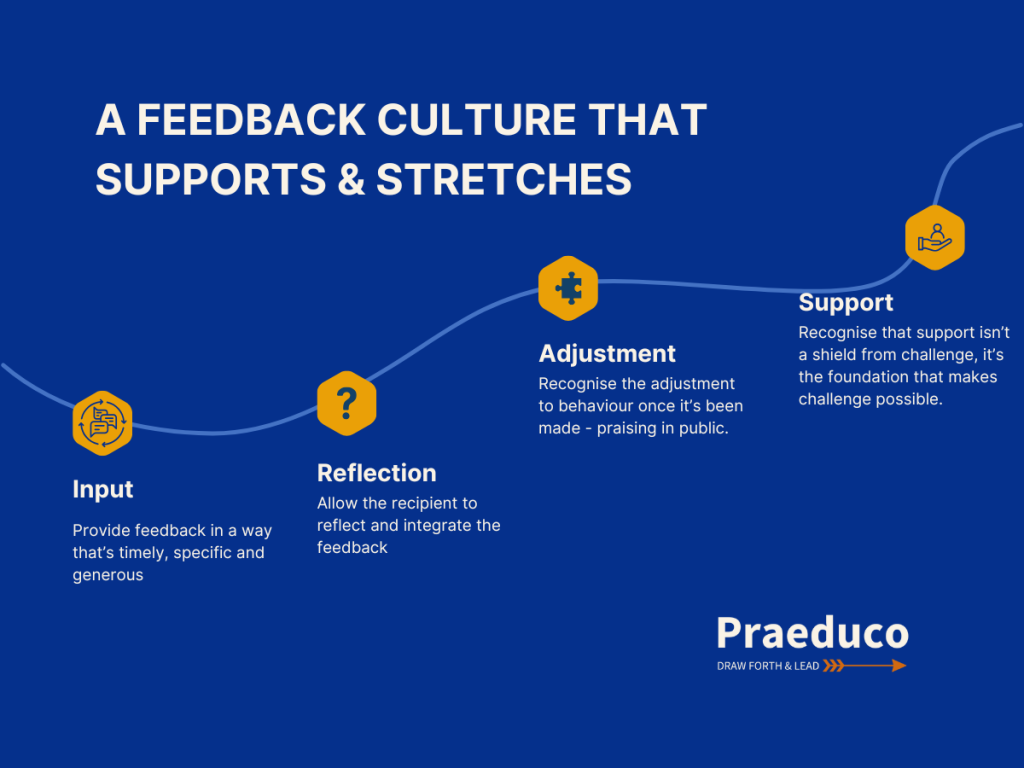Safe, Not Soft: How to Balance Support and Challenge in High-Performing Teams
In today’s corporate landscape, building a feedback culture has become essential to team performance. Leaders increasingly understand that psychological safety is the foundation for innovation, learning, and retention. But somewhere along the way, safety has too often been mistaken for softness—and that’s a problem.
A truly high-performing environment doesn’t just protect people—it pushes them. It combines compassion with candour, support with stretch. And when done well, it creates a feedback culture where individuals not only feel valued, but are also continuously growing.
So how do companies strike that balance?
1. Define Psychological Safety in a Feedback Culture
Psychological safety means people feel safe to speak up, share ideas, admit mistakes, and challenge the status quo without fear of humiliation or punishment. It’s a baseline for trust.
This project is a key strategic priority for the company for the next quarter. That means we can challenge any ad-hoc projects or requests and be mindful of this priority. I’d encourage you to let me know if anything is pulling you away from this so that I can support you.
But psychological safety doesn’t mean we avoid tough conversations. It doesn’t mean withholding feedback, dodging accountability, or tiptoeing around underperformance. In fact, avoiding those things can create more stress and anxiety in a team, not less.
2. Set the Standard: A Feedback Culture That Supports and Stretches
The healthiest cultures are built on both support and challenge. Leaders in these environments communicate clearly:
“I’m here to ensure you’re set up for success. What do you need in order to ensure you can remain focussed on this priority project?
That growth comes with expectations—of curiosity, excellence, honesty, and effort. Teams need to know that support isn’t a shield from challenge; it’s the foundation that makes challenge possible.
I can see you are working long hours and that tells me you aren’t afraid of putting in the work, how are you approaching ensuring that your priorities are clear?
Importantly, help the recipient understand the stakes at play. We do our teams a disservice when we rob them of the opportunity to understand their actions. If something is a non-negotiable behaviour, or a task is business critical, speak plainly that it is so.
You’ve arrived late for the last 2 team meetings. When you do so, you are signalling to the rest of the team that you don’t value their time, impacting the trust within the team and impeding the hard work we are doing together. Can you commit to arriving on time from now on?
At Praeduco, we coach leaders to deliver feedback not as a rebuke, but as a resource. High standards, when framed with care, are a signal of respect.
3. Practice “Tough Love” Feedback
Constructive feedback shouldn’t feel like a personal attack—it should feel like a personal investment. That’s where many companies fall short. They either sugar-coat performance issues until they’re unrecognisable, or deliver feedback so bluntly it leaves people bruised.
There’s a better way:
- Be timely – Feedback given in the moment has the most power.
- Be specific – Generalities create confusion. Precision creates change.
- Be generous – Give feedback with the intention of helping someone be their best, not proving a point.
I’ve noticed that this task has been on your to-do list for several weeks. The impact of this not being done would be …. understanding it’s importance, and knowing that I wouldn’t have asked it if I didn’t believe you were capable of it, what would set you up for success to make this a priority today, and how can I support you?
Praise in public. Challenge in private.
Public recognition boosts morale and reinforces what good looks like. It creates a culture of appreciation that everyone can see and feel. On the flip side, critical feedback—no matter how well intended—should be delivered in private. Public critique erodes trust, even if it’s accurate. Privacy allows for vulnerability, clarity, and growth without the sting of embarrassment.
When leaders model this balance, it becomes embedded in the culture—and feedback stops being feared, and starts being seen for what it really is: a gift.
4. Reward the Right Behaviours
If you only reward outcomes, you risk creating a culture of fear. If you only reward effort, you may breed complacency. But if you reward learning, risk-taking, thoughtful challenge, and growth—you create a thriving, resilient team. Setting a baseline of continuous improvement in a team setting, provides a basis for constant self-reflection and refinement.
Now we’ve seen the draft all together, what’s missing? and how could we make it even better?
Celebrate the person who dared to ask the uncomfortable question in the boardroom. Acknowledge the colleague who gave difficult feedback with grace. Recognise the manager who made space for learning after a failure.
Great question, Thank you. It’s something we could have easily missed if we weren’t thinking critically at every step
5. Build Feedback Culture Into the Everyday
When feedback is regular, expected, and safe—it loses its sting and gains its power. And that’s the heartbeat of a strong feedback culture.
At Praeduco, we guide leadership teams through feedback frameworks that embed this culture. When feedback is regular, expected, and safe—it loses its sting and gains its power.
A Culture Worth Working For
The organisations that will thrive in the next decade won’t just be the ones that feel good to work in. They’ll be the ones where people are supported and stretched. Safe and bold. Compassionate and candid.
Creating that balance isn’t always easy. But it’s always worth it.

Ready to Create a Culture That Thrives on Feedback?
At Praeduco, we help leadership teams build cultures where honest feedback, mutual respect, and high performance go hand in hand. If you’re ready to foster a feedback culture that fuels growth—not burnout—get in touch.
👉 Let’s talk about how we can support your team.
Leave a Reply